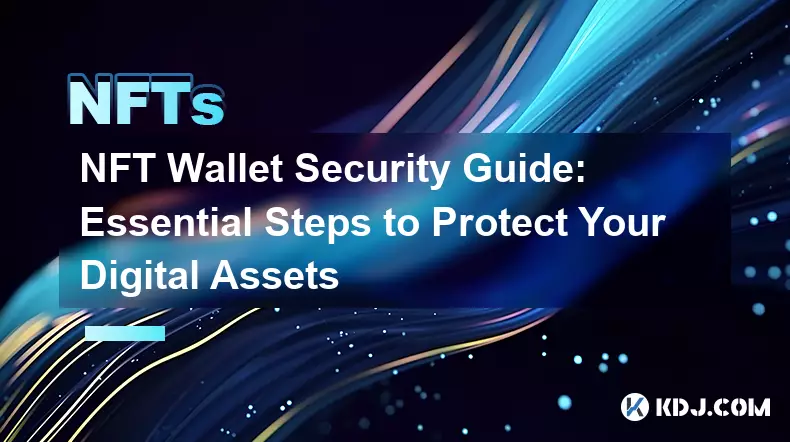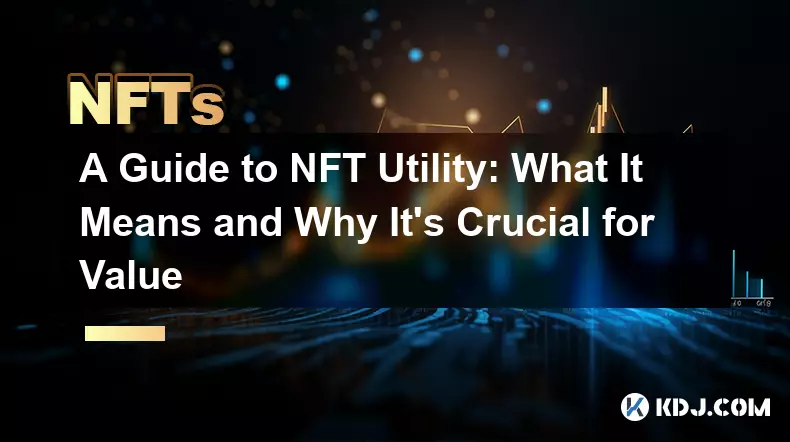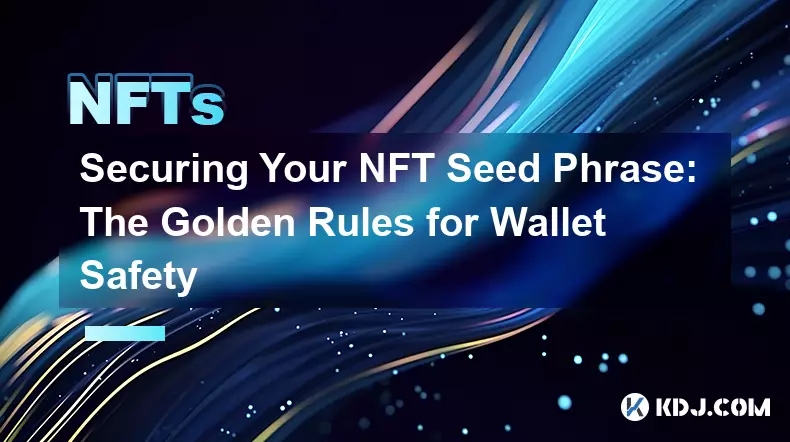-
 bitcoin
bitcoin $107015.826941 USD
-2.18% -
 ethereum
ethereum $3637.352324 USD
-5.18% -
 tether
tether $0.999831 USD
-0.02% -
 xrp
xrp $2.338078 USD
-6.23% -
 bnb
bnb $998.272150 USD
-6.97% -
 solana
solana $167.598257 USD
-10.12% -
 usd-coin
usd-coin $0.999863 USD
0.01% -
 tron
tron $0.282573 USD
-5.09% -
 dogecoin
dogecoin $0.169891 USD
-7.39% -
 cardano
cardano $0.557554 USD
-7.03% -
 hyperliquid
hyperliquid $39.914802 USD
-5.85% -
 chainlink
chainlink $15.414549 USD
-9.97% -
 bitcoin-cash
bitcoin-cash $510.361911 USD
-4.26% -
 ethena-usde
ethena-usde $0.999194 USD
-0.03% -
 stellar
stellar $0.282092 USD
-6.07%
NFT Wallet Security Guide: Essential Steps to Protect Your Digital Assets
Protect your NFTs by securing your private keys, using non-custodial wallets, verifying URLs, and enabling 2FA—always stay vigilant against phishing and malware. (154 characters)
Nov 04, 2025 at 08:54 am

NFT Wallet Security Fundamentals
1. NFTs are stored on blockchain networks, and access to them is controlled through digital wallets that hold private keys. These keys act as the sole proof of ownership and control over your assets. If someone gains access to your private key, they can transfer or sell your NFTs without your permission. Protecting your wallet is not just about safeguarding data—it’s about preserving value.
2. The most secure wallets are non-custodial, meaning only you have access to your private keys. Custodial wallets, often provided by exchanges, store your keys on your behalf. While convenient, they introduce third-party risk. A breach at the exchange could result in irreversible loss of your NFTs. Opting for a self-custody solution ensures full autonomy.
3. Always use wallets with open-source code so the community can audit their security. Closed-source wallets may contain hidden vulnerabilities or backdoors. Transparency allows developers and users to verify that no malicious code has been embedded into the software.
4. When setting up a new wallet, write down your recovery phrase—a sequence of 12 or 24 words—and store it offline. Never save it digitally, including screenshots, cloud storage, or messaging apps. Physical storage options like metal seed phrase plates resist fire, water, and wear better than paper.
Common Threats in the NFT Space
1. Phishing attacks remain one of the top methods used to steal NFTs. Fraudsters create fake websites or emails mimicking legitimate platforms like OpenSea or Blur. They trick users into connecting their wallets or entering recovery phrases. Always double-check URLs and never click links from unsolicited messages.
2. Malware targeting clipboard contents can replace cryptocurrency addresses during copy-paste actions. You might think you're sending funds to a known address, but the malware swaps it with the attacker's. This also applies when approving transactions involving NFT transfers.
Always verify wallet addresses manually before confirming any transaction.3. Fake minting sites lure users with promises of rare NFT drops. Once connected, these sites request excessive permissions, such as full wallet access instead of just approval for a specific action. Grant minimal permissions necessary and revoke unused ones regularly using tools like Revoke.cash.
4. Social engineering tactics exploit trust. Scammers impersonate support staff or well-known figures in Discord or Twitter communities. They offer help or exclusive opportunities, leading victims to sign malicious transactions disguised as harmless actions.
Best Practices for Active NFT Holders
1. Use a dedicated wallet solely for NFTs. Avoid reusing wallets across multiple platforms or for trading volatile tokens. Isolating your NFT holdings reduces exposure if another part of your crypto activity gets compromised.
2. Enable two-factor authentication (2FA) wherever applicable, especially on accounts linked to your wallet. Use authenticator apps rather than SMS-based 2FA, which is vulnerable to SIM-swapping attacks.
3. Regularly review active connections between your wallet and dApps. Disconnect services you no longer use. Many platforms retain indefinite access even after a single login, creating long-term attack surfaces.
Limit wallet connectivity to trusted platforms only and audit permissions monthly.4. Consider using hardware wallets like Ledger or Trezor for storing high-value NFTs. These devices keep private keys offline and require physical confirmation for transactions, significantly reducing remote hacking risks.
5. Stay informed about known scams and emerging threats within the NFT ecosystem. Follow reputable security researchers and community moderators who share timely warnings about malicious contracts or impersonation attempts.
Recovery and Emergency Protocols
1. In the event of a suspected compromise, disconnect your wallet from all connected applications immediately. This prevents ongoing exploitation if an attacker has gained partial access.
2. Transfer your remaining assets to a new, clean wallet generated with a fresh recovery phrase. Assume the original wallet is no longer secure, even if no theft has occurred yet.
3. Document the incident with transaction hashes, timestamps, and involved addresses. Report the details to blockchain analysis firms or community watchlists to alert others and potentially track misuse.
4. Monitor your digital footprint. Search your wallet address on public forums and marketplaces to see if it appears in scam lists or suspicious listings. Early detection can prevent further damage.
Frequently Asked Questions
What should I do if I accidentally approve a malicious smart contract?Immediately disconnect your wallet from all dApps. Check token approvals using a revocation tool and cancel any unauthorized permissions. Monitor your wallet closely for unexpected transfers and consider moving assets to a new wallet.
Can someone steal my NFTs just by knowing my wallet address?No. A wallet address is public information and does not grant access. Theft requires either your private key, recovery phrase, or your signature on a malicious transaction. Public addresses alone pose no direct threat.
Is it safe to connect my wallet to NFT marketplaces?It is generally safe when connecting to verified, well-known platforms. However, always ensure you’re on the correct website and understand what permissions you’re granting. Avoid signing unknown messages or transactions.
How often should I update my wallet software?Update your wallet software whenever a new version is released, especially if it includes security patches. Developers frequently address vulnerabilities, and running outdated software increases exposure to known exploits.
Disclaimer:info@kdj.com
The information provided is not trading advice. kdj.com does not assume any responsibility for any investments made based on the information provided in this article. Cryptocurrencies are highly volatile and it is highly recommended that you invest with caution after thorough research!
If you believe that the content used on this website infringes your copyright, please contact us immediately (info@kdj.com) and we will delete it promptly.
- ZKsync Tokenomics: Utility Shift or Just Another Altcoin Bounce?
- 2025-11-05 00:40:13
- BTC, UK, Treasury Plan: Smarter Web's Bold Bitcoin Bet
- 2025-11-05 01:00:17
- Veterans Day Salute: Army & Air Force Exchange's Coin Giveaway and More!
- 2025-11-05 01:30:12
- Altcoin Investment in 2025: Is BlockchainFX Outperforming Render and Pudgy Penguins?
- 2025-11-05 01:30:12
- Blockchain Gaming: Digital Assets Unlock New Value and Combat Bots
- 2025-11-05 01:10:02
- Crypto Payroll's Meme Coin Dilemma: Hype vs. Stability, Ya Feel?
- 2025-11-05 01:20:01
Related knowledge

NFT Portfolio Tracking: The Best Tools to Manage Your Investments
Nov 04,2025 at 11:04pm
NFT Portfolio Tracking: Why It Matters in the Digital Asset Space1. The rapid expansion of the NFT market has made it essential for collectors and inv...

The Complete Guide to NFT Whitelists: Strategy for Gaining Access
Nov 03,2025 at 02:36pm
Decentralized Exchanges Gain Momentum in 20241. Decentralized exchanges (DEXs) have seen a significant rise in trading volume, surpassing centralized ...

Verifying NFT Authenticity: A Checklist to Avoid Fakes and Scams
Nov 01,2025 at 03:55pm
Understanding the Foundations of NFT Verification1. Every NFT is built on a blockchain, most commonly Ethereum, Solana, or Polygon. The blockchain pro...

Polygon (Matic) NFT Guide: Why It's a Top Choice for Low-Fee Trading
Nov 02,2025 at 06:36pm
Bitcoin's Role in Decentralized Finance1. Bitcoin remains the cornerstone of decentralized finance, serving as a primary store of value within the cry...

A Guide to NFT Utility: What It Means and Why It's Crucial for Value
Nov 01,2025 at 12:54am
Understanding NFT Utility in the Digital Economy1. NFT utility refers to the functional value that a non-fungible token provides beyond its existence ...

Securing Your NFT Seed Phrase: The Golden Rules for Wallet Safety
Nov 03,2025 at 09:54pm
Understanding the Importance of Your NFT Seed Phrase1. The seed phrase, typically a sequence of 12 or 24 words, acts as the master key to your digital...

NFT Portfolio Tracking: The Best Tools to Manage Your Investments
Nov 04,2025 at 11:04pm
NFT Portfolio Tracking: Why It Matters in the Digital Asset Space1. The rapid expansion of the NFT market has made it essential for collectors and inv...

The Complete Guide to NFT Whitelists: Strategy for Gaining Access
Nov 03,2025 at 02:36pm
Decentralized Exchanges Gain Momentum in 20241. Decentralized exchanges (DEXs) have seen a significant rise in trading volume, surpassing centralized ...

Verifying NFT Authenticity: A Checklist to Avoid Fakes and Scams
Nov 01,2025 at 03:55pm
Understanding the Foundations of NFT Verification1. Every NFT is built on a blockchain, most commonly Ethereum, Solana, or Polygon. The blockchain pro...

Polygon (Matic) NFT Guide: Why It's a Top Choice for Low-Fee Trading
Nov 02,2025 at 06:36pm
Bitcoin's Role in Decentralized Finance1. Bitcoin remains the cornerstone of decentralized finance, serving as a primary store of value within the cry...

A Guide to NFT Utility: What It Means and Why It's Crucial for Value
Nov 01,2025 at 12:54am
Understanding NFT Utility in the Digital Economy1. NFT utility refers to the functional value that a non-fungible token provides beyond its existence ...

Securing Your NFT Seed Phrase: The Golden Rules for Wallet Safety
Nov 03,2025 at 09:54pm
Understanding the Importance of Your NFT Seed Phrase1. The seed phrase, typically a sequence of 12 or 24 words, acts as the master key to your digital...
See all articles










































































